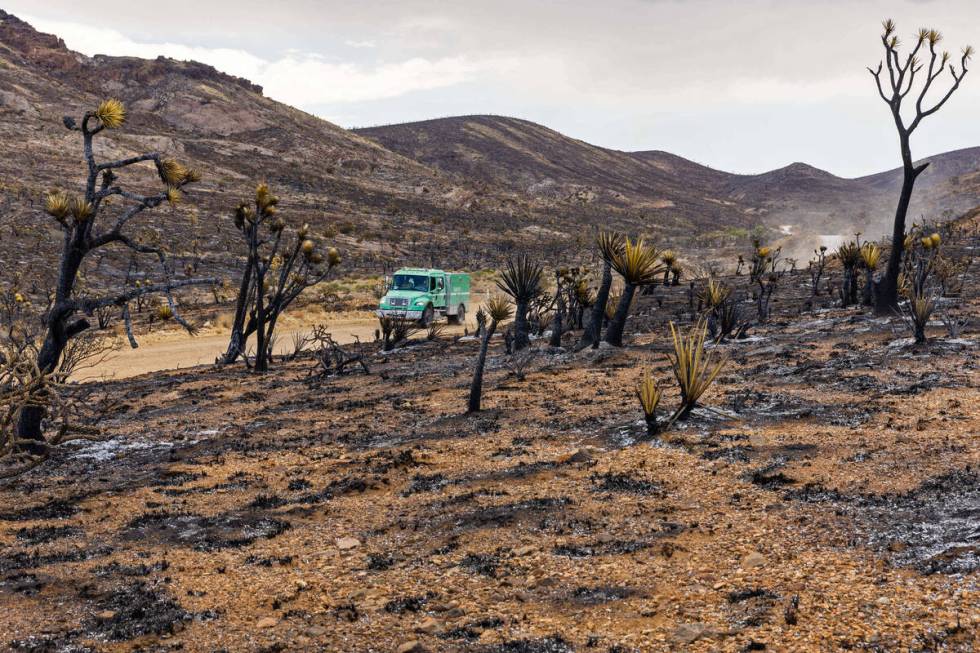Firefighters brace for dry weather in York Fire battle

Fire crews had brought about a third of the York Fire under control on Wednesday as the blaze was also burning in the Avi Kwa Ame National Monument in Nevada.
Rain over parts of the fire has helped, officials said Wednesday. But the next few days were expected to be warmer and drier and firefighters were “remaining vigilant and prepared,” said an update posted to the federal government’s fire-tracking InciWeb site Wednesday.
“The bottom line is that we’re prepared for the change in the weather and we’re going to be very vigilant,” said Marc Peebles, a U.S. Forest Service spokesperson.
Peebles said the fire’s size was 94,009 acres, or about 147 square miles, on Wednesday night. That’s up from the fire’s size of 80,400 acres, or about 125 square miles, on Tuesday.
Peebles said that while the fire did grow, the large jump in numbers reflects the most recent mapping of the fire and not necessarily a large jump in its actual size. Whereas the fire’s size was gauged by an infrared-equipped flight over it earlier in the week, the most recent determination of the fire’s size came from field observers and firefighters on the ground, Peebles said.
Peebles also said almost 8,580 acres of the fire, or about 13 square miles, were burning in Nevada, all of it in the national monument, which is in Clark County.
The fire was 34 percent contained Wednesday night. Just over 400 people had been assigned to help fight the fire, the update said.
Asked if there was concern that the expected dry weather would cause the fire to grow and spread significantly over the next few days, Peebles said that likely wouldn’t happen.
“Given the amount of rain we’ve had and the amount of firefighters we have in the area, that’s probably not very likely,” Peebles said.
The approximately 500,000-acre Avi Kwa Ame National Monument stretches from the Newberry mountains in the east to the New York Mountains south and to the Castle and Piute mountains in the west. It is considered one of the most sacred places on Earth to about a dozen Yuman-speaking tribes that have traced their origins to the land.
The fire started in the Mojave National Preserve on Friday, and its cause was still under investigation Wednesday.
A haze of smoke, pushed north by winds from the south, brought orange-tinged skies and air quality concerns to the Las Vegas Valley before rain clouds Tuesday replaced the smoke.
Clark County spokesperson Stephanie Wheatley wrote in a statement that none of the structures in the towns of Nipton, in California, and Searchlight, in Nevada, were in danger as of Wednesday afternoon, and the county did not plan to issue evacuation orders.
“The fire has started to recede from Nevada, but changing weather conditions are being monitored,” Wheatley wrote.
Peebles also said Tuesday there was no threat to the Las Vegas metropolitan area.
Flash flood warnings
The fire region was included in two flash flood warnings within 24 hours this week from the National Weather Service.
The first, issued Tuesday at 4 p.m., led to about an inch of rain on the eastern parts of the Mojave National Preserve, according to meteorologist Brian Planz, of the Las Vegas forecast office of the National Weather Service.
Chris Outler, also a meteorologist at the Las Vegas office, said Wednesday evening that there had been some scattered rainfall on the far eastern and southern parts of the fire on Wednesday, producing light amounts of precipitation, but mostly the conditions were dry.
After Wednesday afternoon, dry conditions were expected for at least the next five days, Planz said.
Roughly 400 firefighters battling the blaze have had to balance their efforts with concerns about disrupting the fragile ecosystem in the preserve, according to a report from The Associated Press.
Crews used a “light hand on the land,” clearing and carving fire lines without the use of bulldozers in order to reduce the impact in the ecologically sensitive region, which is home to some 200 rare plants.
“You bring a bunch of bulldozers in there, you may or may not stop the fire, but you’ll put a scar on the landscape that’ll last generations,” Tim Chavez, an assistant chief for the California Department of Forestry and Fire Protection, told The Associated Press.
The desert landscape is varied — from mountains and canyons, to sand dunes and mesas, to Joshua tree forests and volcanic cinder cones — and features about 10,000 threatened desert tortoises within its boundaries.
The blaze ignited near the remote Caruthers Canyon area of the vast wildland preserve, crossed the state line into Nevada on Sunday and sent smoke further east into the Las Vegas Valley.
The fire started on private lands, officials said, but they were still trying to learn how. Less than 3 percent of the land in the 2,500-square-mile preserve is privately owned.
While it’s one of the largest preserves outside of Alaska and Hawaii, the vast majority of the Mojave National Preserve’s 880,000 visitors last year were just passing through on their way between Southern California and Las Vegas.
Contact Sabrina Schnur at sschnur@reviewjournal.com or 702-383-0278. Follow @sabrina_schnur on Twitter. Contact Brett Clarkson at bclarkson@reviewjournal.com. The Associated Press contributed to this story.